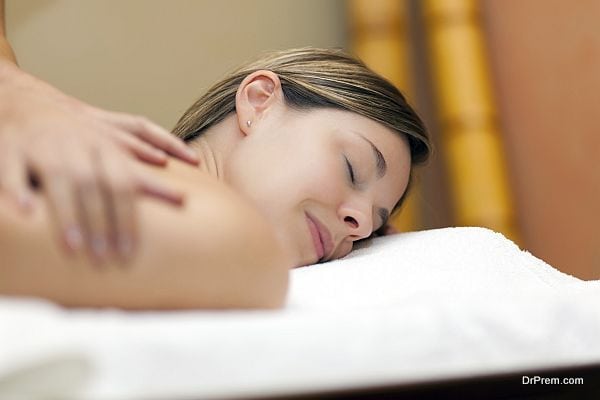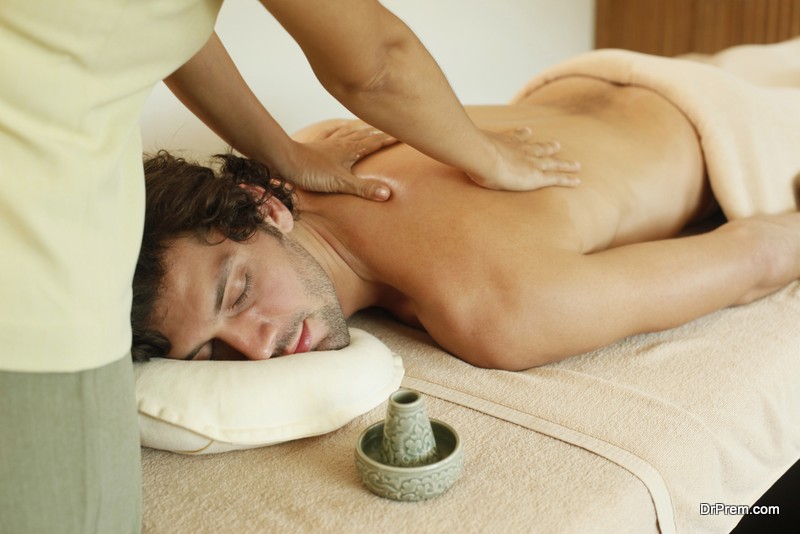Getting a massage is one of the best ways to pamper yourself. But it’s about more than just indulging in some relaxing, personal time (although that’s beneficial as well). Athletes use massage therapy to prevent and treat injuries and massage helps both insomnia sufferers and those suffering from digestive issues and chronic pain. Read on to discover 8 amazing benefits and reasons to consider treating yourself to a massage.
1. Reduce Stress
 This is one of the most popular reasons for getting a massage. Not only does it feel amazing, but it helps relax both your body and your mind. Most spas and massage facilities are designed with the customer’s relaxation in mind. Dim lights, soft music, candles, and essential oils are all part of the experience. The masseuse doesn’t always speak during the session, unless prompted by the customer. But the stress relief you experience during a massage isn’t all mental. Studies show that following a massage, levels of cortisol are lower. Cortisol is the hormone that your body produces during stressful situations. Less cortisol in your system means you’re feeling less stressed and more at ease.
This is one of the most popular reasons for getting a massage. Not only does it feel amazing, but it helps relax both your body and your mind. Most spas and massage facilities are designed with the customer’s relaxation in mind. Dim lights, soft music, candles, and essential oils are all part of the experience. The masseuse doesn’t always speak during the session, unless prompted by the customer. But the stress relief you experience during a massage isn’t all mental. Studies show that following a massage, levels of cortisol are lower. Cortisol is the hormone that your body produces during stressful situations. Less cortisol in your system means you’re feeling less stressed and more at ease.
2. Improve Sleep
Thousands of people struggle from sleep disorders ranging from insomnia to sleep apnea. Even if you don’t have a diagnosed sleep disorder, broken sleep and trouble falling asleep are commonly reported issues. Because massage reduces stress, eases sore muscles, and releases tension throughout the body, it makes for a better night’s sleep. You can more easily find a comfortable sleep position and with less stress and tension, your mind can relax as well. High levels of stress can actually cause insomnia. When your mind is racing, your heart rate increases, making your body more alert and farther from sleep. A relaxing massage can help you catch some much-needed z’s.
3. Treat an Injury
 If you’ve recently incurred an injury, your doctor may refer you to both a physical therapist and a masseuse. Massage improves circulation and blood flow, which speeds up the healing process. Along with increased blood flow, massage helps increase the flow of oxygen and nutrients to vital organs, tissues, and the injured area. Massage also increases flexibility, which aids in the healing process. Massage following an injury may be uncomfortable at first. Depending on where you’re injury is, how severe, and your pain tolerance, the masseuse will work at your comfort level. Doing too much too soon can reverse the healing process and cause you additional discomfort. Communicate with your massage therapist about your needs and pain level.
If you’ve recently incurred an injury, your doctor may refer you to both a physical therapist and a masseuse. Massage improves circulation and blood flow, which speeds up the healing process. Along with increased blood flow, massage helps increase the flow of oxygen and nutrients to vital organs, tissues, and the injured area. Massage also increases flexibility, which aids in the healing process. Massage following an injury may be uncomfortable at first. Depending on where you’re injury is, how severe, and your pain tolerance, the masseuse will work at your comfort level. Doing too much too soon can reverse the healing process and cause you additional discomfort. Communicate with your massage therapist about your needs and pain level.
4. Prevent an Injury
Why wait until you get injured to see a masseuse? Countless athletes use massage as a preventative measure. To prevent an injury, you should keep your muscles loose, flexible and healthy. Most sports-related injuries are due to pulled, strained, or torn ligaments, tendons, and muscles. Massage helps loosen and strengthen these areas of the body. It also promotes healthy blood flow, oxygen levels, and nutrients, making your muscles stronger and reducing your risk of injury. Sports massage can also increase mobility and range of motion. This website details the benefits of massage for athletes. Not only can massage help prevent injury but it may also improve an athlete’s performance and stamina.
5. Relieve Pain
 Another common reason people get a massage is to relieve muscle pain and soreness. The most common problem areas people report are the back, neck, and shoulders. These are often the areas the masseuse will focus on. People experience sore, stiff, and tight muscles for a variety of reasons including lack of exercise, standing or sitting for too long, stress, or poor posture. General muscle soreness is common and is often caused by muscle contractions pressing on surrounding nerves. Massage can reduce muscle contractions, spasms, and nerve compression. It also relaxes the tissue, tendons, and ligaments that tighten and cause spasms and pressure on the nerves. The “knots” you sometimes feel in your neck and back are caused by contractions even when your muscles are at rest. A masseuse can gently release this muscle tension through massage.
Another common reason people get a massage is to relieve muscle pain and soreness. The most common problem areas people report are the back, neck, and shoulders. These are often the areas the masseuse will focus on. People experience sore, stiff, and tight muscles for a variety of reasons including lack of exercise, standing or sitting for too long, stress, or poor posture. General muscle soreness is common and is often caused by muscle contractions pressing on surrounding nerves. Massage can reduce muscle contractions, spasms, and nerve compression. It also relaxes the tissue, tendons, and ligaments that tighten and cause spasms and pressure on the nerves. The “knots” you sometimes feel in your neck and back are caused by contractions even when your muscles are at rest. A masseuse can gently release this muscle tension through massage.
6. Improve Digestion
Digestive issues encompass a wide range of issues including excess gas, indigestion, constipation, and even IBS (irritable bowel syndrome). Changes in your diet, using probiotics, and eliminating certain foods and drinks can all improve your digestive system. But so can massage. Certain types of massage can tone and stimulate the small and large intestines. This stimulation helps your intestines absorb fat and improves your stomach’s “mixing actions” during digestion. If you suffer from constipation or diarrhea, massage stimulates the peristalsis, which is the constriction and relaxation of the muscles in the intestines, offering relief. The benefits of massage are closely linked to the autonomic nervous system (ANS). Normalizing the ANS through massage can also help normalize digestion.
7. Increase Flexibility
 The looser your muscles are, the more flexible you’ll become. That’s why consistency with stretching can improve flexibility over time. Massage can help keep your muscles loose, strong, and malleable. But massage doesn’t only benefit your muscles. Massage is proven to keep your joints more fluid also, which helps prevent injury and improve your range of motion. When your tendons, ligaments, joints, muscles, and all connective tissues are healthy, you can more easily move and stretch them without fear of injury. Deep tissue massage is especially helpful for increasing flexibility. Other ways to improve flexibility include yoga, stretching before and after a workout, and staying hydrated.
The looser your muscles are, the more flexible you’ll become. That’s why consistency with stretching can improve flexibility over time. Massage can help keep your muscles loose, strong, and malleable. But massage doesn’t only benefit your muscles. Massage is proven to keep your joints more fluid also, which helps prevent injury and improve your range of motion. When your tendons, ligaments, joints, muscles, and all connective tissues are healthy, you can more easily move and stretch them without fear of injury. Deep tissue massage is especially helpful for increasing flexibility. Other ways to improve flexibility include yoga, stretching before and after a workout, and staying hydrated.
8. Promote Healthy Circulation
Many people face a lot of problems due to poor circulation. When your blood doesn’t flow properly throughout your body, it deprives vital organs and muscles of adequate oxygen and nutrients. Poor circulation is commonly found in the extremities of the body, including the legs and arms. Symptoms of poor circulation include numbness and tingling in the hands and feet, cold hands and feet, swelling, fatigue, and cognitive dysfunction. Massage can help improve blood flow throughout the body. As the masseuse pushes and pulls on your muscles, it improves the circulation of lymph fluids. These fluids are responsible for carrying waste away from your muscles and internal organs. Massage can also help flush lactic acid from the muscles. The combination of these methods improves overall body function, circulation, and may reduce blood pressure.
A final note
The next time you’re feeling stressed, tense, or simply in need of some rejuvenation, consider a massage. This therapeutic healing method can help ease discomfort, improve functionality, and prevent future injury.
Article Submitted By Community Writer




